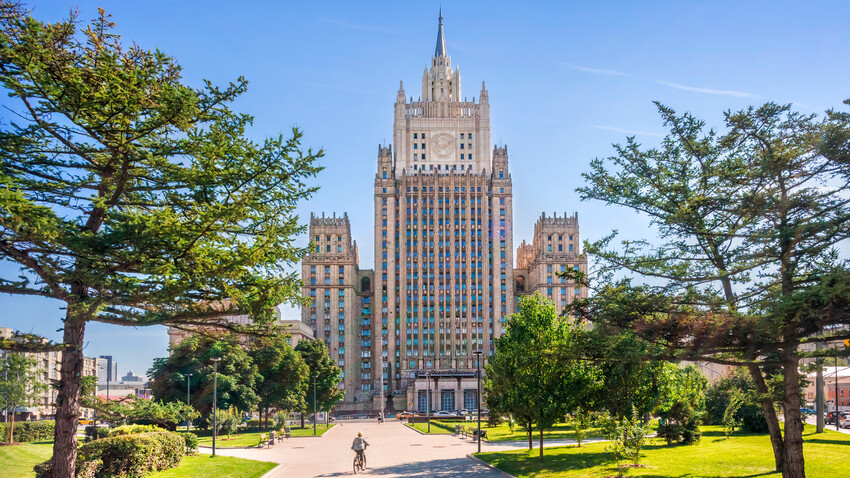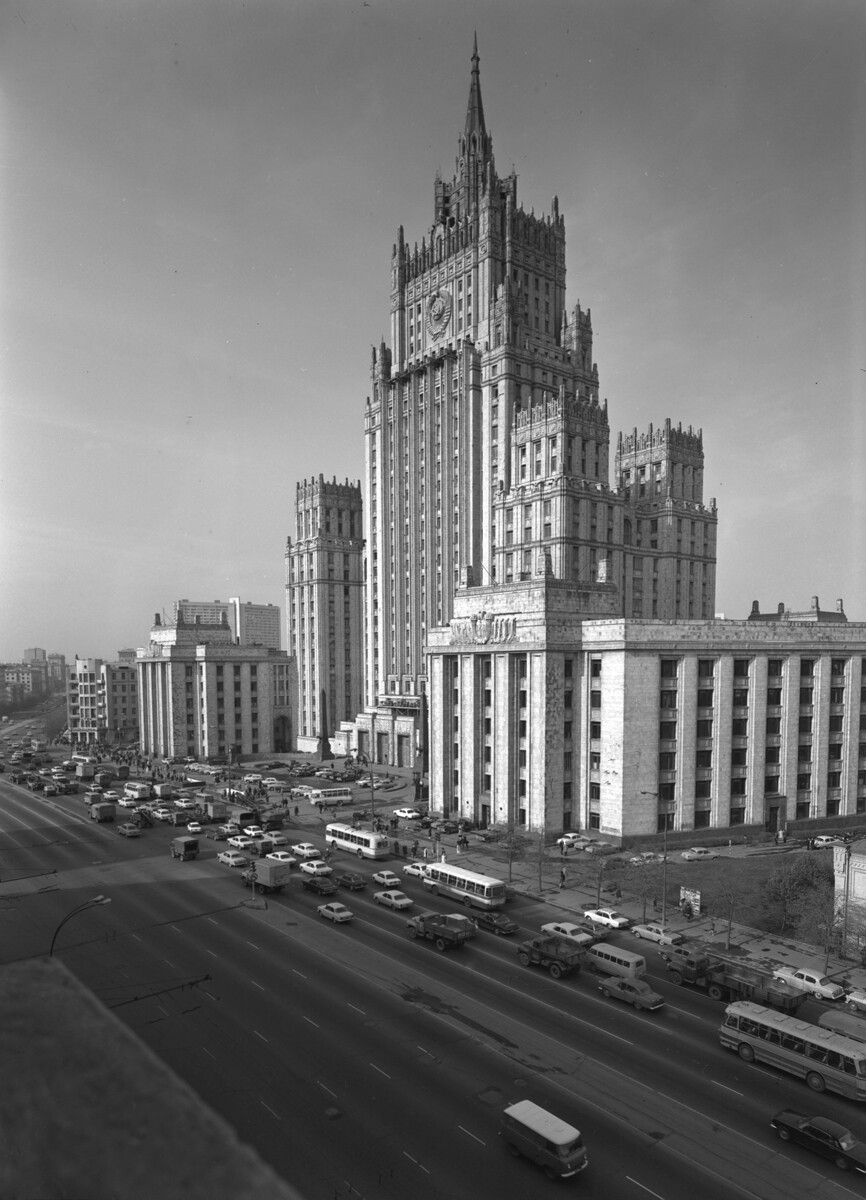
Address: Smolenskaya-Sennaya Ploschad 32/34. Closest subway station: Smolenskaya
Years of construction: 1948-1953
What’s inside: The offices of Russia’s foreign ministry, the Museum of Diplomacy and a massive archive
Construction began together with the other six skyscrapers, on September 7, 1947 - Moscow’s birthday. It was then that the decision was made to turn the 27-storey building into the offices of the Ministry of Foreign Affairs.
One interesting feature of the building was the chosen construction method itself. After the foundation and metallic facade were completed, the building was then finished from the top down, instead of the other way around: concrete was being poured into the top storeys first, at the height of 172 meters, with the construction gradually progressing down as it hardened.
The methods used were cutting edge for their day and age and previously unused in the USSR. The technology allowed for the construction to proceed in incredibly cramped downtown areas, which traditionally make it difficult for a full-blown construction to be rolled out with its tall cranes: in the case of the Ministry of Foreign Affairs building, light cranes were placed on top of the building, as it was being constructed, without taking up any space in the surrounding vicinity.
The project belonged to two architects - Vladimir Gelfreikh and Mikhail Minikus - both of whom received the Stalin Prize. Construction took five years, which added very tight constraints for a project of such magnitude.
At the time of construction, the Ministry of Foreign Affairs high-rise was considered one of the most technologically advanced of all of ‘Stalin’s Vysotkas’: a record-breaking 28 elevators were installed, more than half of which were the fast kind. There were also four stair lifts. And no expense was spared when it came to the interiors - marble, granite and velvet were all used.
But, perhaps, the most interesting feature of the building was the actual spire. It didn’t exist in the original project. Moreover, a flat roof was initially planned. However, on the eve of the 34th anniversary of the October Revolution, Stalin personally ordered the construction of a spire, despite the fact that the project didn’t presuppose the inclusion of any additional heavyweight features: there was a strong risk of the entire building collapsing. According to an urban legend, Stalin supposedly didn’t want the building to be too reminiscent of the American architecture of those days.
Gelfreikh even tried to convince Stalin to abandon the idea, but the latter didn’t listen. In order to solve the problem without adding too much risk, the decision was made to mount a fake spire on top of the Ministry of Foreign Affairs building. Instead of stone, it was to be made from lightweight sheets of metal and plywood.

Even so, the construction was something to behold. At 350 tons, it continued to look fragile and unstable. Nobody wanted to be the one tasked with installing a five-pointed star at the top - which is why the Ministry of Foreign Affairs ‘vysotka’ continues to be the only one without the trademark star (that way, you always know which one you’re looking at!).
After Stalin’s death, Mikhail Minkus, who co-designed the building, actually wrote to Nikita Khuschev with an appeal to remove the spire. The response he got was that the spire “shall remain as a monument to Stalin’s foolishness”.
In 2016, the spire was finally swapped out for a new one, as it had almost completely rusted and was in danger of collapsing at any moment. The old spire was sawed apart for souvenirs to be gifted to the foreign ministry’s VIP guests, while the new one continues to stand today.

It had already become apparent during construction that the building’s final form would not have the desired visual effect from the blueprints. It was, therefore, decided to create a small square in front of it, in order to “leave some breathing room”. And, in order for the building not to look overimposing against the backdrop of smaller, historical buildings, two more buildings of comparable size were erected close by - the ‘Belgrade’ and ‘Golden Ring’ hotels. These additions dramatically changed the look of the main entrance to the city center. The appearance of the ‘Seven Sisters’ became the first step on the way to transforming the low-rise capital into the megapolis that Moscow is today.

Simply walking in from the street is not possible - the Ministry of Foreign Affairs building is, after all, a government building. The fifth floor houses the Center of the History of Russian Diplomatic Service, which organizes tours. However, not everyone can get in - only students of specific Moscow universities, future civil servants and staff. Ordinary tourists, sadly, will have to use their imagination!
If using any of Russia Beyond's content, partly or in full, always provide an active hyperlink to the original material.
Subscribe
to our newsletter!
Get the week's best stories straight to your inbox